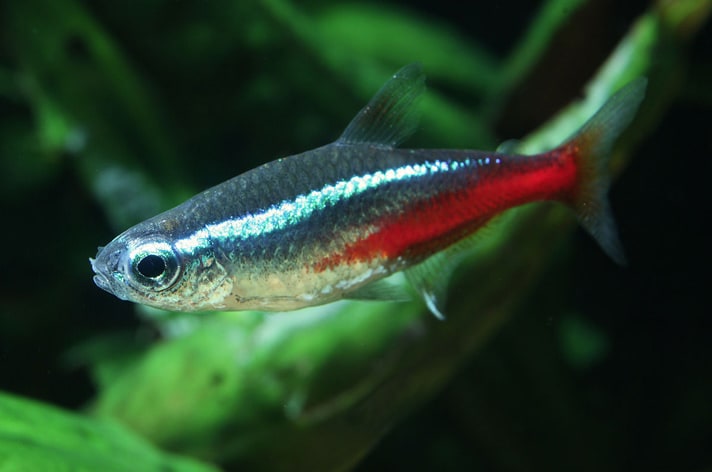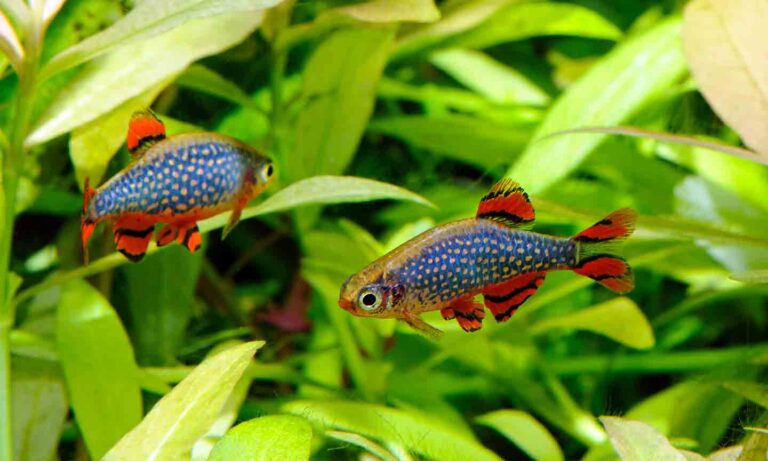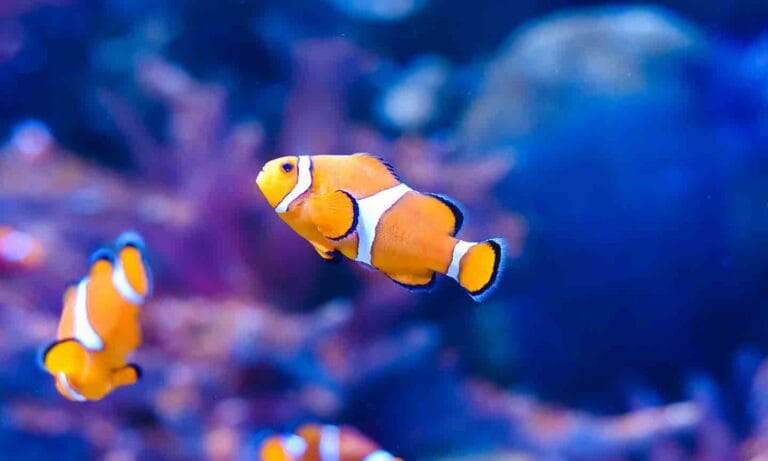These attractive community fish are more appealing in groups. The Characin family includes a huge number of species found in South America and Africa; the smaller members of this group include piranhas, pacus, neons and the famous African tiger fish often referred to as tetras. Tetras, by definition, are small in size. They are usually not aggressive schooling fish and are ideally suited to the community aquarium. Besides the neon and cardinal tetra, several species have been kept by nearly every hobbyist at one time or another.
To create a beautiful community fish aquarium, start on paper, and plan the size and location of the aquarium as well as the species living in it. A well-thought-out community of fish with similar water-quality and size requirements will avoid many problems later. Plan around a key species, usually a cichlid or other gregarious and interesting fish, and choose tankmates around it that will not get eaten or bother your key species.
A basic fact is true for all tetras: They are more sensitive to white spot (ich) disease than many other aquarium fish. Always quarantine new fish in a small aquarium of 5 to 10 gallons for one week, getting them used to your water and food, in addition to guarding against this prevalent disease. Have the medication your store recommends on hand, and carefully check the fish during their quarantine. Once they are feeding properly and free from signs of disease, the fish can be introduced to the community. This is best done with dimmed lights to reduce stress on the new fish and a light feeding to distract the established population.
The life span of most tetras is similar; small fishes live anywhere from 3 to 5 years, until they begin to age rapidly and die. The larger fishes, such as the Congo tetra, can live up to 8 years.
While most tetra species have similar requirements, let us look at the most popular species in the hobby today and how their requirements differ. Of course, this list is somewhat arbitrary, as fish go in and out of fashion, and different cities often have different “most popular” fish species, but you will find that some are consistent. Only one of these species is from Africa, and with good reason: Few African tetras are produced by fish farms, and exporting wild fish from Africa remains an adventure with a low-success rate.
Red-eye tetra (Moenkhausia sanctaefilomenae)
The red-eye tetra (Moenkhausia sanctaefilomenae) is one of the easier species to keep.
The red-eye tetra is perhaps the easiest species to keep. It lives in the Peruvian Amazon lowland, but all red-eyes in stores today are bred in farms in Florida or Singapore. With a maximum size of just 2 inches and large scales, they are small enough to fit any community aquarium, tough enough to act as dither fish for smaller cichlids, and big enough not to get eaten by angelfish and other species with a large mouth. In nature, red-eyes live in the upper portion of the water column but always in shallow water. Often, they are seen hovering in small troops of five to 10 fish under overhanging marginal plants or floating plants. This species very much likes to feed from the surface, hunting for insects and small crustaceans.
Kept alone, they are often unhappy in the aquarium and will simply stay in the corner. For a 20-gallon aquarium, a group of six individuals is ideal. An even number of sexes is most interesting and will bring out the most behavior. This species will readily breed in a heavily planted aquarium. Eggs are laid in java moss or the roots of plants in early morning hours. The male’s body shape is more slender and elegant, while the female is more rounded with somewhat shorter first rays on their dorsal and anal fins. This fish would be my first choice for an aquarium with angelfish, corydoras catfish and Asian barbs, which do not always mix well with South American tetras; the faster, more-agile barbs outcompete the more delicate tetras.
Temp: 71 to 96 degrees Fahrenheit
pH: 6 to 7.5
Hardness: Not critical
Size: 2 inches
Food: Flake or frozen food
Plants: New growth is sometimes eaten
Orientation: Top one-third of the tankSerpae or blood tetra
Serpae tetra (Hyphessobrycon eques)
Hyphessobrycon eques can tolerate cooler water, even unheated aquariums, and it is also easy to breed and resistant to disease. On the other hand, this tough little fish tends to fight, and it likes to nip at the fins of other fish.
The serpae tetra has been misidentified since the earliest days of our hobby, when travelers to Argentina returned with this bright-red tetra, assuming it to be H.serpae. The serpae tetra in our hobby today is actually H.eques, which makes the common name “blood” tetra a little less confusing. The blood tetra has some good characteristics and some that make it less desirable. It can tolerate cooler water, even unheated aquariums, and it is easy to breed and resistant to disease. On the other hand, this tough little fish tends to fight, and it likes to nip the fins of other fish. Despite the small size, this species can hold its own with larger tankmates. Best kept in a group of at least six to eight animals, they are well-suited for aquariums with similar fish, such as Asian barbs or paradise fish. Males have a more elegant and streamlined body shape, in addition to brighter colors. Females have a larger abdomen and higher body shape.
Temp: 64 to 75 degrees Fahrenheit
pH: 7 to 8.5
Hardness: Not critical
Size: 13/4 inches
Food: Flake or frozen food
Plants: New growth is sometimes eaten
Orientation: Bottom one-third of the tank
Hatchetfish (Gasteropelecus sternicla and others)
Gasteropelecus sternicla prefers soft, acidic and very warm water.
Anyone seeing this fish for the first time is immediately drawn to the odd body shape and oversized pectoral fins used for flying over the water when threatened. Several species of hatchetfish are occasionally available in the hobby, collected in several countries in the Amazon basin. While beautiful, hatchets are not the easiest fish to keep: They will fly out of the aquarium if it is not perfectly covered, are easily damaged by the keeper or other fish and, worst of all, they are perhaps the most sensitive fish to ich. To keep hatchetfish, soft, acidic and very warm water is needed, and the surface should not be too close to the covering glass. A distance of 3 inches will allow spooked hatchets to fly several inches over the surface without getting damaged from hitting the ceiling. The giant hatchetfish (G.sternicla) is hardier than the smaller hatchetfish species of the genus Carnegiella, and it can be kept in a community aquarium with smaller fish. The smaller species should be kept in an aquarium with perfect conditions and very small tankmates, such as pencilfish, neons and harmless catfish like Corydoras spp.
Temp: 79 to 89 degrees Fahrenheit
pH: 5 to 7
Hardness: Soft water only
Size: 1 to 13/4 inches
Food: Flake or frozen food
Plants: Will not touch plants
Orientation: Surface
Bleeding-heart tetra (Hyphessobrycon erythrostigma and others)
The bleeding-heart tetra (Hyphessobrycon ehrostigma) prefer temperatures between 77 and 89 degrees Fahrenheit.
There are three species of bleeding-heart tetras; all show a bright-red humeral spot on their flanks. The two species found in Brazil’s Rio Negro are rarely exported. The common bleeding-heart tetra is found in the Peruvian Amazon. Even today, all animals in the hobby are wild-collected, as this species is not easy to breed in captivity. Once the males display the extended dorsal and anal fin, this is one of the most beautiful smaller fishes for the community aquarium. To ensure the males continuously spar, provide a larger aquarium (33 gallons or more) with at least 10 fish, half males and half females. Bleeding-heart tetras are ideal community fish for bigger tankmates, such as dwarf cichlids, gouramis and angelfish.
Temp: 77 to 89 degrees Fahrenheit
pH: 5.5 to 7.5
Hardness: Not critical
Size: 23/4 inches
Food: Flake or frozen food
Plants: New growth is sometimes eaten
Orientation: Bottom half
Congo tetra (Phenacogrammus interruptus)
Phenacogrammus interruptus will grow up to 8 inches in length.
This beautiful fish is actually found in the rapids of the Congo River. There, it feeds on insects, insect larvae and small crustaceans. It will grow up to 8 inches in length. It is surprising that this fish has not only adapted well to life in our aquariums, but it is bred in large numbers and has become a mainstay in the aquarium hobby. Despite its delicate shape, this species is capable of swimming in the strongest currents and enjoys a strong water flow in the aquarium. Farm-raised Congo tetras remain around half the size of wild-caught fish, but they retain the iridescent colors and spectacular fins of the wild specimens. Females and juveniles have little color and short fins, but their presence is necessary to bring out the behavior of the males. A sparring match between males of this species is one of the nicest sights to see in the aquarium. The species is harmless toward other fish and can be a good community fish. Caution with fin-biting species, such as Asian barbs, is required, because the long fins of the Congo tetras are irresistible to them.
Temp: 82 to 89 degrees Fahrenheit
pH: 6 to 7.5
Hardness: Not critical
Size: 4 to 8 inches
Food: any flake or frozen food
Plants: Will not touch plants
Orientation: Middle
Pencilfish (Nannostomus beckfordi ssp.)
Nannostomus beckfordi are found in the Amazon, Orinoco and the Guyanas.
These tiny tetras of the genus Nannostomus are fun to watch and easy to keep if their basic parameters are met. Found in the Amazon, Orinoco and the Guyanas, they are present in every habitat with water that does not move too quickly. The most hardy and common species is N.beckfordi. It is now bred in some numbers by fish farms in Asia and Europe. It is the perfect fish for nano aquariums, harmless to plants and just territorial enough to make it fun to watch. The only problem is the very small mouth of this group. All food must be crushed to small size for them to feed. Pencilfish should always be kept in a group of at least 10 individuals. Males of most species have brighter, more contrasted colors than females. Pencilfish are great community fish for a micro aquarium with other very small tetras, and perhaps Apistogramma spp. (dwarf cichlids) and Corydoras spp.
Temp: 72 to 86 degrees Fahrenheit
pH: 6 to 7.5
Hardness: Not critical
Size: 11/4 inches
Food: Requires very small foods, any flake or crushed frozen
Plants: Will not touch plants
Orientation: All areas of the aquarium
Rummynose tetra (Hemigrammus bleheri, H. rhodostomus or Petitella georgiae)
Rummynose tetras, like these Petitella georgiae, are good community fish for very small tankmates.
Rummynose tetras actually belong to three species found in the Orinoco and Amazon basin. Today, most are exported from Brazil, Peru and Colombia. Rummynoses are good community fish for very small tankmates. If other fish are larger than them, they easily get dominated and quickly begin to fade. Despite their popularity, these fish are often one of the first to die in the aquarium of inexperienced keepers, so it is not the best fish for your first aquarium. A group with at least 20 individuals ensures they is less nervous and brings out their subtle coloration.
Temp: 77 to 89 degrees Fahrenheit
pH: 5 to 7
Hardness: Soft water only
Size: 2 inches
Food: Flake or frozen food
Plants: Will not touch plants
Orientation: Bottom one-third of the tank
Black widow tetra (Gymnocorymbus ternetzi)
Black widow tetras (Gymnocorymbus ternetzi) are also called black-skirt tetras.
The black, or black widow, tetra may be the easiest species of tetra. Originally found in Paraguay and parts of Bolivia and Argentina, this little fish has been a mainstay in the aquarium hobby since the earliest days of fishkeeping. The fish in our aquarium stores are usually bred in Southeast Asia or Florida and easy to quarantine and acclimate. They are hearty and seem to do well in a community tank with any number of species. As a beginner, this species is the best choice from our top ten. Black tetras can be kept with most common community fishes, but they do best in small loose groups of at least 10. Males are smaller, with darker black color, than the more rounded and faded females.
Temp: 66 to 86 degrees Fahrenheit
pH: 6 to 8
Hardness: Not critical
Size: 2 inches
Food: Flake or frozen food
Plants: New growth of some plants is nibbled by some individuals
Orientation: Bottom half
Neon tetra (Paracheirodon innesi)
The neon tetra (Paracheirodon innesi) is more tolerant of water conditions and temperatures than the cardinal tetra.
They are best kept in a community of other tiny fish. The most famous tetra is found in the Amazon lowland in Peru, Colombia and Brazil. The neon tetra is perhaps less attractive than the cardinal tetra, but it is more tolerant of water condition and temperature. Neon tetras in the hobby today are often raised in Southeast Asia and prone to bacterial disease, brought in from the crowded conditions at the farm and intensified during shipping. Before purchasing neons or cardinal tetras, make sure the fish in the vendor’s aquarium are healthy. If they show white patches or unclear fins, better to wait until they have stabilized. Females are more rounded and somewhat larger than the slender males. A nice group of neon tetras should consist of at least 15 fish, and they are best kept in a community of other tiny fish. Neon tetras and cardinals are not species for a mixed-community tank with angelfish, barbs, gouramis and other larger community fish.
Temp: 72 to 86 degrees Fahrenheit
pH: 6 to 7.5
Hardness: Not critical
Size: 11/2 inches
Food: Flake or frozen food
Plants: Will not touch plants
Orientation: Bottom half
Cardinal tetra (Paracheirodon axelrodi)
Cardinal tetras (Paracheirodon axelrodi) can be somewhat more sensitive than neons, but they are strong fish if their preferred water parameters are met.
The cardinal tetras in our hobby are all wild-collected in clear streams of the Colombian Orinoco or Brazilian Rio Negro. Cardinal tetras are a perfect example of how sustainable development can help local communities to earn an income without harming the environment. In other words: Their purchase, and that of many wild-collected freshwater fish, is helping to protect the rain forests. Fishermen and local people protect habitats that have a natural use to them. Sustainable collection of fish generates income. The alternative jobs for people living in the Amazon include logging, gold mining and working for the mega-farms, all factors in the rapid destruction of the Amazon.
In the aquarium, cardinal tetras can be somewhat more sensitive than neons, but they are strong fish if their preferred water parameters are met. Like neons, they should be the center point of a community aquarium, where they form tight groups (at least 15 individuals) and have only very small, harmless fish as their tankmates.
Temp: 75 to 89 degrees Fahrenheit
pH: 5 to 7
Hardness: Soft water required
Size: 2 inches
Food: Flake or frozen food
Plants: Will not touch plants
Orientation: Bottom half
Breeding Tetras
Breeding tetras is generally not so difficult. The males and females should be kept separate for two weeks and fed well. Bring them together in a suitable small breeding tank (10 to 30 gallons, depending on the size of the species), and they will usually spawn the next morning. All of the species in our top 10 are egg scatterers that will simple spawn in the open water or place eggs in the roots of plants. Parents usually eat their eggs and young, so they must be removed immediately after spawning. Several days later, depending on the species and temperature, the eggs hatch and tiny fry emerge. Here lies the biggest problem: The fry are so small that they must feed on protozoae, microorganisms that can be cultured with green water on a window sill. After 10 to 14 days, the fry quickly grow in size and can accept larger foods, such as newly hatched brine shrimp and crushed flake food.
In Closing
Tetras are perhaps the easiest aquarium fish to keep. Their low level of aggression, small size and schooling behavior make them ideally suited for the average aquarium. Their bright colors and territorial behavior have fascinated hobbyists for over a century. Even the most experienced keeper with many aquariums will usually have at least one aquarium with tetras. Unlike the more sensitive livebearers or often more nervous barbs, this group of fishes is the perfect fit for any community aquarium.
Oliver Lucanus has kept fish professionally for more than 25 years. His main interest is the natural habitats of our aquarium fish, and he has spent a lot of time observing fish in nature all over the world.
Read More:
Breeding Tetras
Posted by: Chewy Editorial
Share:










